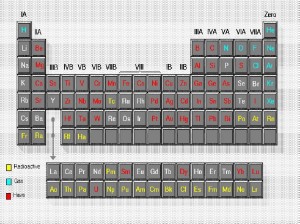– Not many people, other than my close friends, know that I’ve been putting together a collection of the elements of the Periodic Table for a long time.
– Hence, my interest in the British Geological Survey Risk List 2011 of the world’s rare and expensive elements in the original article.
– This next table, however, is about my personal collection and indicates which elements I’ve got in my collection now.
– Key:
Red – I’ve got it
White – I don’t
Blue – It’s a gas
Yellow – Radioactive
– dennis
– And now to the original article…
= = = = = = = = = = = = = = = = = = = = = = =
A new supply risk index for chemical elements or element groups which are of economic value
The risk list gives a quick indication of the relative risk in 2011 to the supply of the chemical elements or element groups which we need to maintain our economy and lifestyle. The position of an element on this list is determined by a number of factors which might impact on supply. These include the abundance of elements in the Earth’s crust, the location of current production and reserves, and the political stability of those locations.
The risk list highlights a group of elements where global production is concentrated in a few countries. The restricted supply base combined with the relatively low political stability ratings for some major producing countries significantly increase risk to supply. The list highlights economically important metals which are at risk of supply disruption including rare earths, platinum group metals, niobium and tungsten. The list also shows the current importance of China in production of many metals and minerals.
As demand for metals and minerals increases, driven by relentless growth in the emerging economies in Asia and South America, competition for resources is growing. Human factors such as geopolitics , resource nationalism, along with events such as strikes and accidents are the most likely to disrupt supply. Policy-makers, industry and consumers should be concerned about supply risk and the need to diversify supply from Earth resources, from recycling more and doing more with less, and also about the environmental implications of burgeoning consumption.
The list focuses on risks to supply and does not include any assessment of factors that influence demand, such as criticality of an element to a particular technology or how easy it is to substitute that element with another.
Download the Risk list 2011 publication.
– To the Original… ➡
